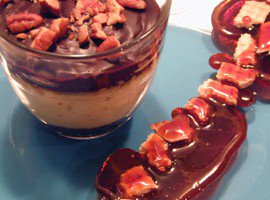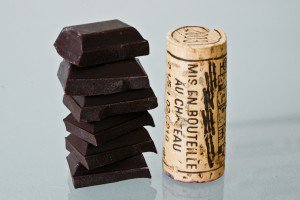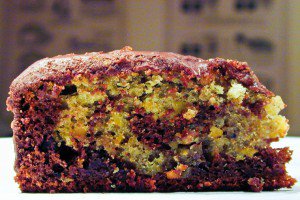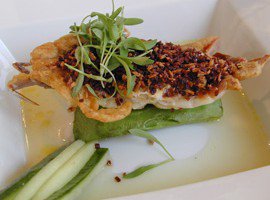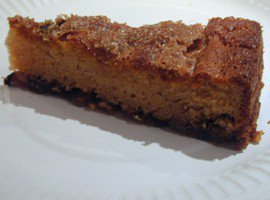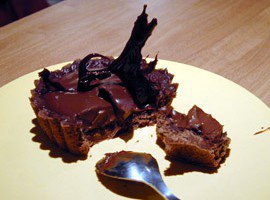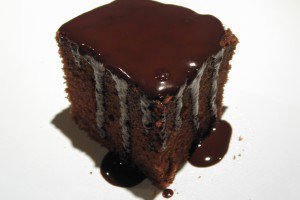Update, spring 2004 : Le Troyon is now closed, but the same team now runs Caïus at 6 rue d’Armaillé in the 17th (01 42 27 19 20).
[Very surprisingly, Le Troyon does not give out little address cards like most restaurants do, so I don’t have a picture for this entry!]
Last Monday, my parents invited Maxence and I to dinner at Le Troyon, Maxence’s favorite restaurant in Paris. This was our fourth time eating there, we had raved about it to my parents, and they were eager to try it. The setting is elegant but intimate, and the service is professional yet friendly. They have a three-course menu that runs at 33 euros and changes every day but for some signature items.
As is the style in a lot of Parisian restaurants, the menu is hand-written in chalk on blackboards, that the waiters carry to each table for diners to read, propping it up on your table, or balancing it on a chair or a shelf close to you. I like the dynamic of that, because people squint, they turn their necks, they comment on the spelling, wonder about a word that they can’t quite make out, and is it “cul” or “col“, and they’re all looking in the same direction, instead of being isolated behind their own menu.
When you are ready to make your choice (or not, as is more often the case), the waiter will stand next to the board and answer questions, decipher the handwriting, describe dishes, give advice, discuss the choice of products. I love that part because that’s when I get to enquire about what this or that is served with, and how is it prepared, and do you recommend it, and will I like it, and does the chef like it, and where do you buy the bread, and what’s a good wine pairing, and how’s the business going, and can I work here? Until I feel everybody’s getting impatient and I just shut up already.
Most of the dishes at Le Troyon start with something traditionally French, twisted into a refined and inventive dish, using seasonal fresh products and plated with skill.
We had been served amuse-bouches in the past, but no such luck this time. It just dawned on me as I write though, I didn’t miss it at the time – possibly because they did bring a basket of fresh and warm dinner rolls… For starters, Maxence and I had “Potage de lentilles vertes du Puy en cappucino, copeaux de foie gras” : a creamy green lentil soup, covered with a delicate cream froth, on which two thin slices of foie gras had been deposited. This was served in a shallow white square bowl. Very very good. My father had the “Os à moëlle à la fleur de sel, légumes pot-au-feu“, a huge bone marrow sprinkled with fleur de sel, on a rectangular white plate, with an assortment of the boiled vegetables typically found in pot-au-feu (carrot, potatoe and turnip) in a shallow bowl identical to ours. My mother had “Aubergine et tomates confites, pois chiches en salade” : layers of eggplant and tomatoes, topped with a little mound of seasoned chick peas.
As a main course, my father and Maxence both had the “Col-vert rôti“, roasted duck thighs served with mashed potatoes. They both raved about it. My mother had the “Dos de bar de chahut“, grilled sea bass served with roasted fennel, which she enjoyed very much. And I had “Gnocchis frais de pomme de terre et légumes aux deux cuissons” : fresh potatoe gnocchis served with vegetables cooked two ways, caramelized and sauteed. I wasn’t too impressed by the gnocchis : they were good, but not really that superior to store-bought gnocchis, and I recently made ricotta gnocchis that I liked better. The vegetables on the other hand were very tasty, a nice and flavorful mix of young carrots, green onions, fingerling potatoes and celery.
For dessert, my father had the Mont-Blanc, a layered dessert made of light meringue, crème de marron (chesnut purée) and whipped cream. For those of you who wouldn’t know, the Mont-Blanc (literally “white mountain”) is the highest French mountain, in the Alps. My mother had the figs roasted in wine and balsamic vinegar.
Of course, I had to have the “Moelleux au chocolat“, which is a small chocolate cake that’s liquid inside and oozes thick chocolate goodness when you break into it with your spoon. This dessert was first imagined and elaborated by chef Michel Bras, and the original version is very delicate to make : the inside is in fact a frozen disk of ganache that he carefully places in the chocolate cake dough in a small mold, and the ganache melts as the cake part cooks. It took him a long time to figure out what the right balance of ganache vs. cake dough should be to obtain just the texture he envisioned. A simpler version of it (a chocolate cake that’s not thoroughly cooked inside) has since become a highly popular classic in French restaurants. Here, the moelleux was served with a high and narrow ramequin filled with vanilla ice-cream.
Maxence went for the moelleux too, which is somewhat out of character : he usually won’t go for chocolate desserts of his own accord, unless I ask him to “help me out” with one. I usually don’t have to plead too hard once it gets on the table though!
We then ordered coffee, with which we were served speculoos, those Belgian cinnamon ginger crunchy cookies, in a metal box full of various spices that had infused the cookies, giving them a very subtle flavor.
As always, a great dining experience, and a very friendly evening.
Le Troyon
4 rue Troyon
75017 Paris
01 40 68 99 40


